Keywords
|
| Artificial Neural Networks, Under frequency Load Shedding, Blackout, Power System Stability, Adaptive Neuro Fuzzy Inference System. |
INTRODUCTION
|
| Basic principles in the power system operation are frequency and voltage stability [1]. Under normal operation of a power system, the total system generation is equal to the sum of all running loads plus all real power losses in the system. |
| On occurrence of any disturbance in the power system, there will be imbalance between load and generation. This will cause insufficient generation to match the system load resulting in a frequency drop. Operation of power system at reduced frequency level is a dangerous situation. Power system frequency is a continuously changing variable which is a function of generation supply and load demand in the power system. Recently, one of the main challenges of electric power utilities is power system blackout [2]. Severe system disturbances can result in cascading outages and isolation of areas causing formation of electrical islands. If such an islanded area is under generated, it will experience a frequency decline. Unless sufficient generation with ability to rapidly increase output is available, the frequency decline will be largely determined by frequency sensitive characteristics of loads [3]. To prevent extended operation of separated areas at lower than normal frequency, load shedding schemes are employed to reduce the connected load to a level that can be safely supplied by available generation. Under frequency load shedding is a common practice for electric utilities for preventing frequency drop in power systems following a disturbance [4]. The best load shedding scheme is one that is able to separate the least possible loads of the network in the shortest time by considering power system constraints. Old load shedding schemes do not have the existing potentials and also they are time consuming and results in unnecessary and extra load shed. In this paper, artificial intelligence is used to solve the load shedding problems and to provide the best load shedding scheme. |
| Adaptive Artificial Neural Networks (ANN) is an intelligent method that has gained attraction in the recent years. The high speed neural networks can provide optimal load shedding in steady state as well as in transient states unlike other intelligent methods. This method is able to determine all load shedding steps simultaneously. The design of an adaptive load shedding method by neural networks is developed in [5]. Neural network has been used in a number of ways in connection with load shedding problems. In [8], neural network is employed for the prediction of load shedding function on the basis of frequency reduction. This reference shows that the use of ANN algorithm against traditional load shedding methods is at least hundred times faster. In this paper, load shedding strategy is presented in a new structure using ANN. Taking into account the importance of inputs for neural network training, four inputs are selected. They are total network generation power (Pg), the total load in the power system (Pl) the amount of spinning reserved capacity and the frequency reduction rate. Spinning reserve capacity in the network is important in reducing the load shedding amount and preserving the system stability in case of a disturbance in the system. The total required amount of load to be shed is considered as the neural network output. This paper also suggests a method to predict the optimal load shedding for any range of input values other than the trained data set using Adaptive Neuro Fuzzy Inference System (ANFIS) for further improving the power system stability. IEEE 39 bus system is used as the test system to carry out the experiments on the functioning of load shedding method. The simulation results show the ability of this method in performing a fast and optimal load shedding. |
| This paper is organized into six sections. Following the introduction, the conventional methods of under frequency load shedding are described in section II. In section III, the proposed ANN method and its structure to obtain the optimal load shedding amount is given. Section IV demonstrates the use of ANFIS which incorporates both the neural networks and fuzzy logic principles thus capturing the benefits of both for the prediction of optimal amount of load shedding for any range of input values other than the trained data. Obtained simulation results are discussed in Section V. Finally, some conclusions are drawn in Section VI. |
CONVENTIONAL LOAD SHEDDING METHODS
|
| A. Breaker Interlock Scheme |
| One of the simplest techniques of carrying out load shedding is Breaker interlock scheme. Here, a source breaker would be interlock via hard wired or remote signals to a set of load breakers that have been pre-selected to trip. The signals are mechanically sent to load breakers to open, when generator breaker is misplaced for any motive. This scheme is very fast as there is no processing time required. But in this scheme, only one stage of load shedding is possible and more over extra loads might get separated from the system. Also, modifications to the system are costly. It is very hard to change load priority, since the actions for load shedding are hardwired and amount of load shedding is calculated for the worst case scenario. |
| B. Under Frequency Relay Method |
| Frequency relays react to the disturbances, but do not detect disturbances. They react to the disturbances commonly to both large and small systems. When the first stage is reached, the relay waits for a fixed period of time to avoid nuisance tripping and then trips one or more load breakers. If the frequency continues to the next stage to be reached and after an additional time delay, opens other load breakers. This scheme has number of inherent drawbacks. This scheme has slow response time which is the major drawback. Also, incorrect load may be dropped which may lead to over shedding of load. The unavailability of information for future changes and enhancement of the system will significantly reduce the protection system performance. |
| C. Programmable Logic Controller-Based Load Shedding |
| With PLC scheme, load shedding is limited based on the total load versus the number of under frequency conditions. PLC based load shedding scheme offers many advantages over the frequency based scheme since they have access to information about the actual operating status of the power systems. The drawback of this scheme is that the monitoring of the power system is limited to the section of the system that is connected to the data acquisition system. This drawback is further compounded by the implementation of pre-defined load priority tables in the PLC. The system-wide operating condition is often missing from the decision-making process resulting in insufficient or excessive load shedding. |
THE PROPOSED ANN METHOD
|
| In the proposed method, Levenberg – Marquardt Back Propagation (LMBP) Neural Network is used. Back propagation algorithm is commonly used to train feed forward networks. In LMBP, the data flows from input layer to the hidden layer and finally to the output layer. The error signals generated in the output layer is back propagated to the hidden and input layers. The sum of squares error signals is minimized by adjusting synapse weight coefficients [6]. For training ANN, generation of data set is important. The data’s are collected from power system simulation results using various contingencies such as single and combined unit outages and overloads. For ANN training, the four inputs selected are (a) total network generation power (b) total load in the power system (c) amount of spinning reserve capacity and (d) frequency reduction rate. The required amount of load shedding required is taken as neural network output. The employed ANN structure is shown in Fig 1. |
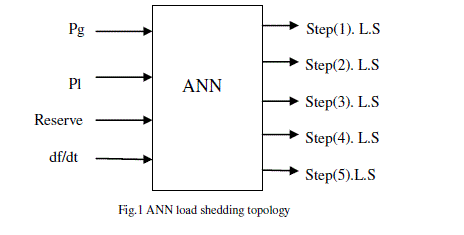 |
| B. ANN Characteristics |
| Appropriate neural network training can be achieved by carrying out training of lots of neural networks. In the proposed ANN characteristics, one hidden layer and 20 hidden neurons are selected. Generalized feed forward neural network is used in this. Commonly, back propagation algorithm is used to train feed forward networks. From the data set created, 90% of the information is used for training: These are presented to the network during training and network is adjusted according to its error, 5% is used for testing: These have no effect on training and so provide an independent measure of network performance during and after training and 5% for cross validation: These are used to measure network generation and to halt training when generalization stops improving. Cross validation is done to prevent over fitting. The specifications of ANN structure is given in Table I. |
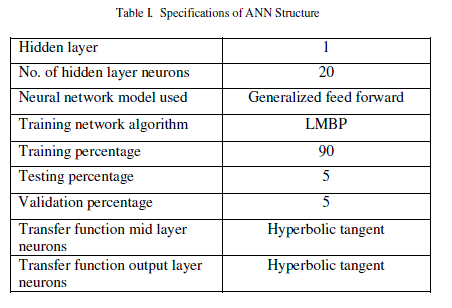 |
| The inputs, targets taken for neural network training and output produced by neural network are shown in Table II. It should be noted that the generated power, Pg and the load power, Pl, are approximately equal only during nominal conditions. During contingencies such as unit outage and overloads, these two variables are not equal. |
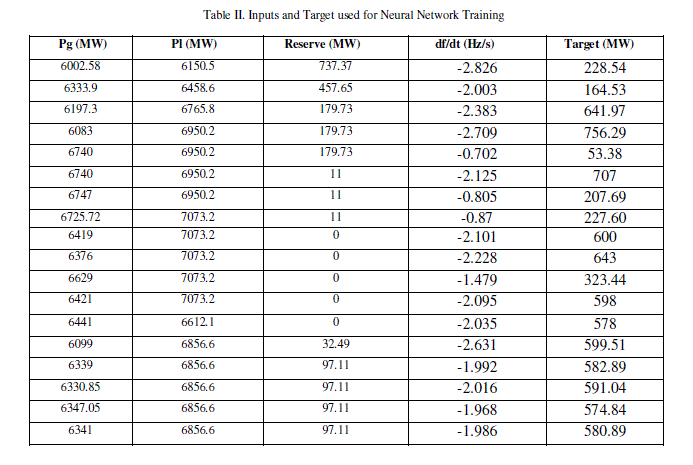 |
| B. Variation of Load Shedding Values in Relation with Inputs |
| Here, variations of total amount of load shedding which is the output of neural networks in relation with the variable inputs are given. Fig 2 shows the variation of load shedding values in relation to the generation changes. It is clear from the graph that as the total generation values increases, the load shedding amount also increases. This is because increase in the generation indicates the increase in the system load. Thus, the amount of load shedding has to increase in order to conserve the network stability from the distortions produced. |
| Fig 3 shows the variation of load shedding values in relation to the total system load. The graph indicates the increase in the load shedding values as the system load increases. System load increase shows an imbalance between the system generation and total system load. This imbalance may be due to distortions in the system like single or combined outages, overloads. Thus, to protect the system against these disturbances and to bring the system back to normal state, load shedding amount should be increased. |
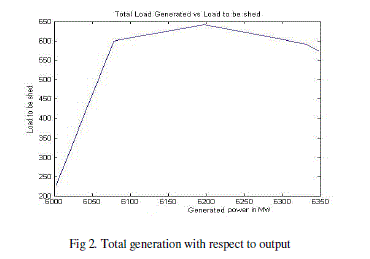 |
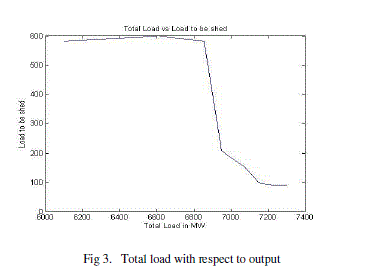 |
| From Fig 4, it is clear that more the spinning reserve capacity, lesser the total amount of load to be shed. This shows the necessity for the presence of suitable reserve capacity percentage in the power system. Spinning reserve is the extra generating capacity that is available by increasing the power output of generators that are already connected to the power system. The presence of adequate reserve capacity reduces the amount of load shedding amount and also helps in preserving the system security. |
| Fig 5 shows the variation of load shedding amount with respect to the rate of frequency amount. . More the severity of the disturbance, the more the rate of frequency reduction will be. Thus, as the rate of reduction of frequency increases, more amount of load should be shed in order to preserve the stability of the power system. |
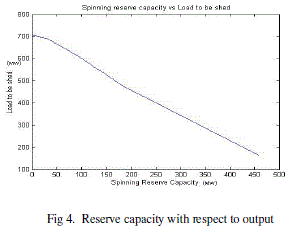 |
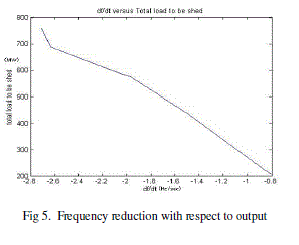 |
ADAPTIVE NEURO FUZZY INFERENCE SYSTEM
|
| ANFIS is a kind of neural network that is based on Takagi Sugeno fuzzy inference system [9]. Since it integrates both neural networks and fuzzy logic principles, it has potential to capture the benefits of both in a single frame work. Its inference system corresponds to a set of fuzzy IF-THEN rules that have learning capability to approximate nonlinear functions. Hence, ANFIS is considered to be a universal estimator. The inference system is a computer program that tries to derive answers from a knowledge base. Fuzzy logic is a multi-valued logic that allows intermediate values to be defined between conventional evaluations like true/false, yes/no, high/low etc. It is a convenient way to map an input space to an output space. Fuzzy logic determines the output based on the membership function and the fuzzy rule set. Membership function of a fuzzy set is a generalization of the indication function in classical sets. In fuzzy logic, it represents the degree of truth as an extension of valuation. Membership function allows to graphically representing a fuzzy set. Membership function used here is triangular form as its computations are simple [7]. |
| A. Methodology |
| ANFIS is used to predict the optimal amount of load shed for any input range other than the trained data set. The data set for ANFIS includes the four inputs for neural network and the output which is the optimal load shedding amount obtained after the neural network training. This data set is divided into two groups: training data and checking data. |
| The training and check data set will be used to train the fuzzy system by adjusting the membership function parameters. The training data appears in the plot as a set of circles and check data appears as pluses superimposed on the training data. The ANFIS parameter optimization method used for Fuzzy Inference System (FIS) training is the hybrid method which is a mixture of back propagation method and least squares method. Training adjusts the membership function parameters. ANFIS provides the optimal amount of load shedding using the membership function and fuzzy rule set with least average testing error of 0.032046. The check data set selected is shown in Table III. |
 |
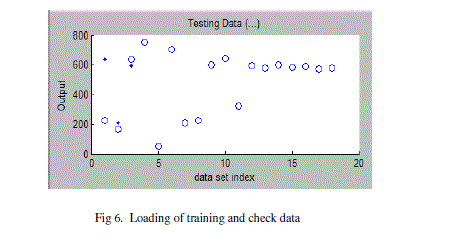 |
| Fuzzy Inference System (FIS) output appears in the plot in red as stars. ANFIS provides the optimal output for any input value range. The average error produced in predicting the optimal value is 0.032046 which is considered to be the least possible error. Fig 7 shows the FIS output and the least possible error produced. |
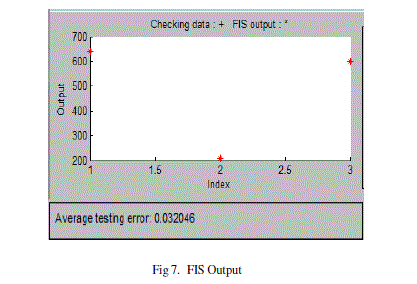 |
SIMULATION RESULTS
|
| In the proposed method, the load shedding problem is solved using adaptive artificial neural networks [10]. The generation of training data set for neural networks is from the power system simulations carried out for single and combined unit outages in IEEE 39 bus system. The data base comprises 18 sets of data for training the ANN. The target and the output produced by neural network are shown in Table IV. From this, it is clear that optimal amount of load shedding is obtained from neural networks. The error plot is shown in Fig 8 |
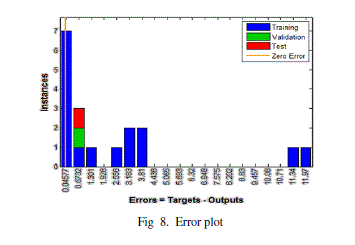 |
| Positive values for the error indicate the optimizing capability of the proposed ANN method. From the performance plot shown in Fig 9, it is clear that the best performance is 0.64557 at epoch 3. It is in the third epoch, the least MSE value. To extent the optimizing capability for any range of input values and to enhance the stability of the power system, ANFIS is used. It provides the optimal load shedding amount for any values of input other than the trained data set. It predicts the output with least average testing error. Simulations are carried using ANN tool box of MATLAB. |
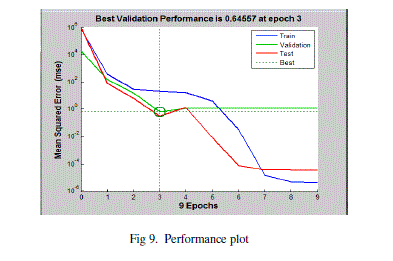 |
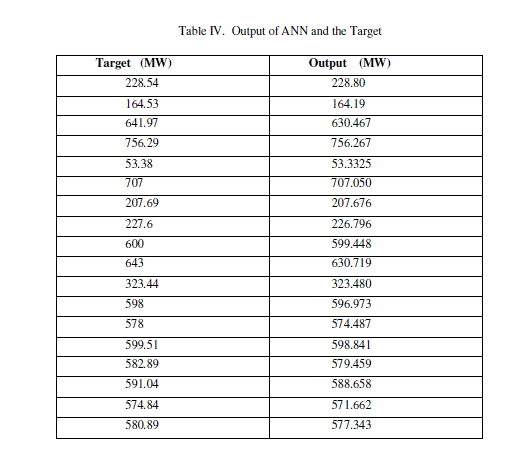 |
| A. Test System |
| The test system used to demonstrate the effectiveness of the proposed system is IEEE 39 bus system [11] – [13]. The single line diagram of the system is shown in Fig 10. This test system is also called New- England bus system. The system consists of 39 buses and 10 generators. It also consists of 19 load buses, 36 transmission lines and 12 transformers. The total active power is 6150.5 MW and the reactive power capacity is 1409.5 MVAR at nominal conditions. The maximum capacity of the system active power is 7019 MW and its maximum reactive power generation capacity is equal to 2120 MVAR. |
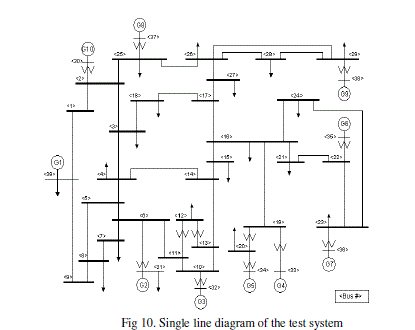 |
CONCLUSION
|
| This paper has developed a new method to solve the load shedding problems using adaptive ANN method. The simulation results show that the proposed method is able to provide optimal amount of load shedding compared to the conventional methods. This method can determine the amount of load shedding in all steps simultaneously that leads to have a higher speed than the traditional methods. ANN is able to provide optimal load shedding in transient states also. To extent the optimizing capability for any range of input values, an integration of both neural network and fuzzy logic is used which is called ANFIS. By providing the output of the neural network as input to ANFIS, it can predict the optimal load shedding values for any input values other than the trained data with least possible average testing error. Thus the stability of the power system is appreciably increased. The simulations are carried out using ANN and ANFIS tool box of MATLAB. |
References
|
- AlirezaSaffarian and MajidSanaye-Pasand,“ Enhancement of power system stability using adaptive combinational load shedding methods”, IEEE Trans.Power Syst..,vol.26, no.3, pp. 1010-1020, Aug. 2011.
- Chang L and Wub Z. “Performance and reliability of electrical power grids under cascading failures”, Electr Power Energy Syst. 2011; 33; 1410-9.
- PrabhaKundur, “Power System Stability and Control”, Tata McGraw-Hill edition, 1993.
- Terzija VV, “Adaptive under frequency load shedding based on the magnitude of the disturbance”, IEEE Trans Power syst.,2006;21; 1260-6.
- Hsu CT , Kang MS and Chen CS, “ Design of adaptive load shedding by artificial neural networks, IEE Proc Gene Trans Distrib 2005;152;415-21.
- M.T.Hagan and M.B.Menhaj, “Training feed forward networks with the Marquardt Algorithm”, IEEE Trans on Neural Networks, Vol.5, No.6, pp.989-93, 1994.
- Chennakesava R. Alavala, “Fuzzy logic and Neural Networks, Basic concepts & Applications”, New Age International publishers, 2008.
- Kottick D, “Neural network for predicting the operation of an under frequency load shedding system, IEEE Trans Power Syst 1996;11;1350-8.
- JyhShing and Roger Jang, “ANFIS: Adaptive neuro fuzzy inference system, IEEE Trans on syst, Man & Cybernetics, Vol.23, no.3, pp.665- 685, May/June 1993.
- M.Moazzami and A.Khodabakhshian, “A new optimal adaptive under frequency load shedding using artificial neural networks”, Proc. Of ICEE, May 2010.
- M.Y.Hussain and V.G.Rau, “ Anefficicent and simple method of dynamic equivalent construction for large multi-machine power system”, IEE International Con on advances in Power System Control, Operation and Management, Hong Kong, 1, 90-4, Nov 1991.
- http:// www.washington.edu/research/pstca. accessed June 2007.
- Y.H.Song and I.K.Yu, “Dynamic load dispatch with voltage security and environmental constraints”. Electric power systems research, Vol.43, pp. 53-60, 1997.
|